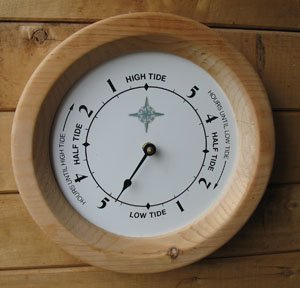3. It might be argued that the original home of the Polynesians was in the tropical belt and that therefore its culture would not have been prone to adopt the idea of a pair of separate 'years'. However, they could themselves had arrived at a similar concept derived from the diurnal movements of the sea. Twice a day the fertile mud flats would be exposed to Sun and in between there would twice a day be a high tide.  The face of the tidal clock covers only one of these cycles. Likewise also our own familiar clock faces show only one half of the day - nighttime is to be measured separately. Day and night are different entities: ... On came the monsters, came Pupa vae noa, and Poroporo tu a huanga, Toke a kura, and Tuna nui himself - they all came rushing on the land. And Tuna stripped off his loincloth, and he held it up; at once a mighty wave reared up and swept toward that land. Then Huahega shouted to her son, to Maui tikitiki, 'Quick now! Show them yours! Pull it out!' Did Maui then as Huahega told him, did as his mother said. That wave fell back, the great wave of the monsters soaked away. The bottom of the sea was bare, and all the monsters floundered on the reef, they flapped in pools ... For the full story of Maui (Sun) and Tuna (Sea) fighting for Hina see at Cor Serpentis. Instead of Sun during the cycle of the solar year in turn visiting his pair of wives - north respectively south of the equator - there is on the chain of Tuamotuan islands a reversal, there is a pair of men who are rivals for the woman. ... Antares, visible in the morning sky of December-January, came to stand for summer heat; hence the saying, 'Rehua cooks (ripens) all fruit'. The generally accepted version of the Rehua myth, according to Best, is that Rehua had two wives, the stars on either side of Antares. One was Ruhi-te-rangi or Pekehawani, the personification of summer languor (ruhi), the other Whaka-onge-kai, She-who-makes-food-scarce before the new crops can be harvested ... |